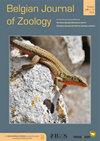Paleoclimate, ecoregion size, and degree of isolation explain regional biodiversity differences among terrestrial vertebrates within the Congo Basin
IF 1.1
4区 生物学
Q2 ZOOLOGY
引用次数: 7
Abstract
One of the most widely recognized patterns in ecology is the increase in species richness from poles to tropics. Literature suggests that the Congolian lowland rainforest does not follow this pattern: the Central Congolian forest (CCLF), south of the Congo River, is thought to harbor fewer vertebrate species and endemics than the Northeastern (NELF) and Northwestern lowland rainforests (NWLF) north of the Congo River. We used data from the Global Biodiversity Information Facility (GBIF) database on terrestrial vertebrates (mammals, birds, and reptiles), to test whether differences in sampling effort caused the irregular biodiversity pattern in this region. Our results show that even though the diversity within the Congolian lowland rainforests remains to be fully mapped, current differences in richness are unlikely to be caused by undersampling alone. We argue that the lower vertebrate richness in the CCLF is due to both its relatively small size and isolated position: Forest cover fluctuated throughout the history of the Congo Basin due to climatic variability, reducing speciation and increasing extinction, while immigration towards the CCLF is limited due to the barrier effect of the Congo River. The implications of these findings are discussed in the context of both fundamental ecology and conservation management.古气候、生态区域大小和隔离程度解释了刚果盆地内陆生脊椎动物的区域生物多样性差异
生态学中最广泛认可的模式之一是从极地到热带地区物种丰富度的增加。文献表明,刚果低地雨林并不遵循这种模式:刚果河以南的中刚果森林(CCLF)被认为比刚果河以北的东北低地雨林(NELF)和西北低地雨林(NWLF)拥有更少的脊椎动物物种和特有种。我们使用了全球生物多样性信息基金(GBIF)数据库中关于陆生脊椎动物(哺乳动物、鸟类和爬行动物)的数据,以测试采样工作的差异是否导致了该地区生物多样性模式的不规则。我们的研究结果表明,尽管Congolian低地雨林的多样性仍有待全面绘制,但目前的丰富度差异不太可能仅由采样不足引起。我们认为,CCLF中较低的脊椎动物丰富度是由于其相对较小的规模和孤立的位置:由于气候变化,森林覆盖率在刚果盆地的整个历史上都在波动,物种形成减少,灭绝增加,而由于刚果河的屏障效应,向CCLF的移民受到限制。这些发现的含义在基础生态学和保护管理的背景下进行了讨论。
本文章由计算机程序翻译,如有差异,请以英文原文为准。
求助全文
约1分钟内获得全文
求助全文
来源期刊

Belgian Journal of Zoology
生物-动物学
CiteScore
1.90
自引率
0.00%
发文量
10
审稿时长
>12 weeks
期刊介绍:
The Belgian Journal of Zoology is an open access journal publishing high-quality research papers in English that are original, of broad interest and hypothesis-driven. Manuscripts on all aspects of zoology are considered, including anatomy, behaviour, developmental biology, ecology, evolution, genetics, genomics and physiology. Manuscripts on veterinary topics are outside of the journal’s scope. The Belgian Journal of Zoology also welcomes reviews, especially from complex or poorly understood research fields in zoology. The Belgian Journal of Zoology does no longer publish purely taxonomic papers. Surveys and reports on novel or invasive animal species for Belgium are considered only if sufficient new biological or biogeographic information is included.
 求助内容:
求助内容: 应助结果提醒方式:
应助结果提醒方式:


